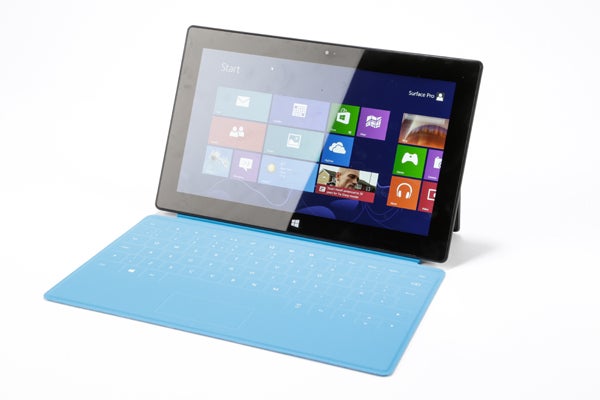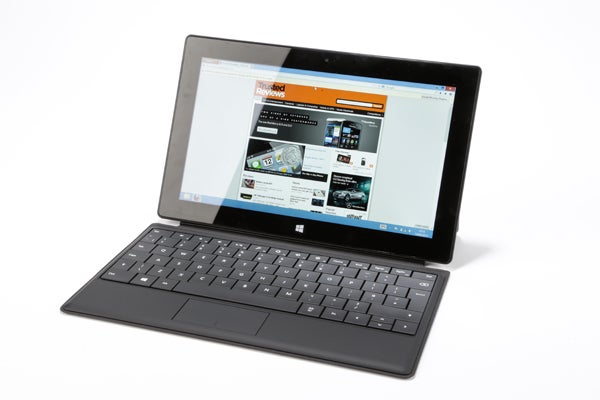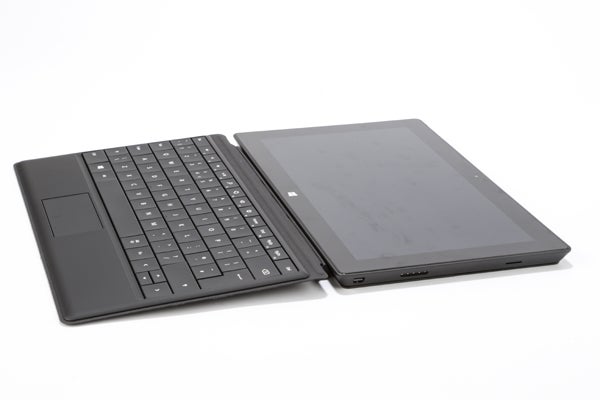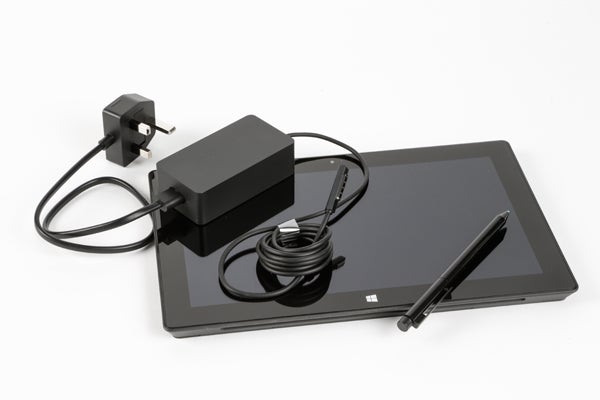Microsoft Surface Pro Review
Microsoft Surface Pro
It's the best Windows 8 hybrid tablet, but does that mean you should buy one?

Sections
- Page 1 Microsoft Surface Pro Review
- Page 2 Screen Quality and Software Review
- Page 3 Battery Life & Performance Review
- Page 4 Touch Cover vs Type Cover and Verdict Review
Verdict
Pros
- Outstanding screen
- Innovative design
- Windows 8 at its best
- Comes with Wacom digitser pen
Cons
- Heat and noise
- No digitiser pen storage
- Woeful battery life
- Shallow app store
Key Specifications
- Review Price: £719.00
What is the Microsoft Surface Pro?
A tough question. It’s neither a straightforward tablet, nor a tablet/laptop hybrid. It’s more ambitious. The Surface Pro is nothing less than an attempt to create the perfect PC for the ‘Post PC’ era. It’s a tablet you can use at home on the sofa. It’s a PC you can plug into a monitor and use in your (home) office. It’s a laptop replacement that lets you work on planes, trains and anywhere between. It’s a digital canvas you can take notes with on a factory floor or building site. It’s all these things. It wants to be all these things. But is it?
Key features: 10.6-inch, 1,920 x 1,080 resolution screen; 1.7GHz Intel Core i7 CPU, 4GB RAM; 64GB or 128GB storage; USB 3.0, microSD, mini-DisplayPort; 276.4 x 173 x 13.5mm, 910 grams

Surface Pro video review
See the Microsoft Surface Pro for yourself with our video review.
Surface Pro vs Surface RT
The Surface Pro’s key features hint at this naked ambition. Its 10.6-inch screen is the same size as the cheaper, £399 Surface RT, but it has an upgraded 1,920 x 1,080 resolution. Instead of a weedy Nvidia Tegra 3 processor, it has a laptop-grade 1.7GHz Intel Core i5 processor. Instead of the crippleware Windows RT, it runs full Windows 8 Pro. It adds a mini-DisplayPort port that lets you connect to any monitor at up to 2,560 x 1,600 resolution. Instead of a merely adequate 2GB RAM, it has 4GB.
There are numerous smaller improvements, too. The Surface Pro has a USB 3.0 port, instead of 2.0; the touchscreen supports 10-points of touch rather than 5-points; and it comes with a Wacom digitizer pen, allowing proper pen input and hand writing recognition – a feature many a dodgy iPad stylus attempts to accomplish with little success.
Finally, there’s the keyboard covers – the touch-based Touch Cover (£99) and the traditional Type Cover (£109). They’re important because, while Surface Pro costs £719 (64GB) or £799 (128GB), neither comes with a cover. They really should. A Surface Pro without one of them… well, it isn’t complete. Add £100 or so for your cover of choice and you reach the true price of a Surface Pro.
What does the Surface Pro 2 have to offer?
Surface Pro – Design & Build Quality
Whichever you choose, it’s a hefty price to pay. But at least Microsoft hasn’t skimped on design or materials. Quite the opposite.
Like the Surface RT, the Surface Pro’s build quality is exemplary. Nowhere is this better demonstrated than in the kickstand that flips out to prop the Surface Pro up, and the magnetic clasp that holds your choice of keyboard cover. The stand has a smooth, reassuring action, while the magnetic clasp is so strong you can lift the Surface Pro up by its cover – emphasis on can, we don’t recommend you do.
The Surface Pro looks fantastic, too – more like an actual ‘slate’ than any tablet we’ve seen. But it’s damn heavy. At 910g, the Surface Pro weighs 230g more than the Surface RT, and at 13.5mm the Surface Pro is 4mm thicker, too. It’s 258g heavier and 4mm thicker than the iPad 4, and that’s before you factor in the Touch Cover (214g) or Type Cover (210g).
Now, before Microsoft fans cry bloody murder… yes, neither is a fair comparison. The Surface Pro is basically a laptop in a tablet body, whereas the Surface RT and iPad 4 use low-power processors that can’t run desktop applications like the Surface Pro.

But the Surface Pro’s extra bulk has a couple of important consequences:
- It’s uncomfortable to use as a tablet for long periods unless you rest it on your arm, leg or other body part, and even then it’s hard to feel comfortable for long.
- It feels as if you’re carrying an actual laptop in your bag, even if it’s a few hundred grams lighter than a MacBook Air.
Neither problem is insurmountable or intolerable, but it’s a flavour of the awkward balancing act Microsoft’s all-purpose hybrid treads.

A more annoying design oversight is the lack of storage for the stylus, or digitizer pen as Microsoft no doubt prefers people call it. It’s damn annoying.
Indeed, at time of writing we’ve actually lost the pen that came with our Surface Pro, and when we did have it, it was invariably where we were not – i.e. at home when at work and vice versa. You can clip the pen onto a cover when using one, but it’s a poor substitute.
Since we’re on niggles, the magnetic charging connection is fiddly to use – a poor imitation of Apple’s mag-safe connections.
How we test tablets
We test every tablet we review thoroughly. We use industry standard tests to compare features properly and we use the tablet as our main device over the review period. We’ll always tell you what we find and we never, ever, accept money to review a product.

